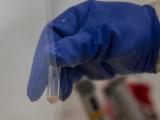Jan 24, 2002 (CIDRAP News) British and American scientists have teamed up with several technology corporations in seeking to enlist personal-computer (PC) owners from around the world in the hunt for a molecule that can keep the anthrax toxin out of human cells.
The group hopes to assemble thousands of PCs into a "virtual supercomputer" that can speed the task of screening a database of molecules to find potential inhibitors of the anthrax toxin, according to announcements this week by Oxford University and other organizations involved in the effort. Lists of molecules generated by the project will be made available to the US government and other friendly states, according to an Oxford press release.
The program is modeled on an existing project called "Cure Cancer with Your Computer," in which 1.3 million PCs are being used to screen a database of more than 3.5 billion molecules in a search for potential anti-cancer drugs. That program was launched by Oxford and the National Foundation for Cancer Research (NFCR, an American organization) last year, officials said. The NFCR's Centre for Computational Drug Design is at Oxford in the United Kingdom.
PC users can join the effort by downloading a screen-saver program at www.researchforacure.com or at www.intel.com/cure. The program enables PCs to be put to work on the research effort when they would otherwise be idle, according to the NFCR. The project is expected to take 3 to 6 months, the NFCR said.
Oxford officials said the research project is being sponsored by Intel and Microsoft. The technology that permits the harnessing of PCs via the Internet is being provided by United Devices, a "distributed computing" software and services company, they said.
Graham Richards, an Oxford chemist and scientific director of the project, commented in the press release, "Massively distributed computing provides efficient and speedy ways to identify new drug candidates. Particularly with anthrax and other related bioterrorist threats, speed to discovery is of the essence. Without this technology and support of our collaborators, there would be no other way to tackle such a tremendous task."
Researchers at Oxford have identified a binding site on the anthrax protein that permits the protein to form a ring with other copies of the protein, thereby enabling the anthrax toxin to enter cells, according to the Oxford release. Knowledge of the binding site makes it possible to screen a database of molecules for those that could block the site, officials said.
A drug that blocks anthrax toxin could be effective against the disease even in advanced cases in which antibiotics no longer work, noted a report on the Intel Corporation's Web site. But the report said it will take "a number of years" to develop a drug from the research project.
The basic methodology used to find the anthrax protein binding site is described in a report to be published in the Journal of the American Chemical Society ("Identification of Ligand Binding Sites on Proteins Using a Multiscale Approach," by Meir Glick et al), the Oxford release said. More details on the target site for anthrax inhibitors will be published in the February issue of Nature Biotechnology ("Protection Against Anthrax: Identification of a Site for Rational Drug Design," by Meir Glick et al).



















